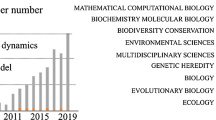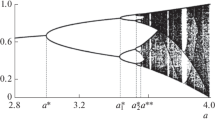Abstract
The paper considers a microevolution model of two-stage population with limitation under the influence of natural selection that regulates juvenile survival rate. An analytical and numerical study of the model is performed; the parametric areas of various dynamic modes are determined. It is shown that an emergence of new alleles (for example, as a result of mutations) providing a greater reproductive potential of individuals leads to a natural selection of these alleles and evolutionary growth of the average value of the reproductive potential in the population. However, in the case of density dependent regulation of birth rate, the increase in the average value of reproductive potential leads to destabilization of the dynamics for the age group sizes. Scenarios of changes in the dynamics are various and depend on the parameter values of the model, but the main result is always the same: the dynamics become more and more complex and, as a rule, chaotic.





Similar content being viewed by others
REFERENCES
Haldane, J.B.S., A mathematical theory of natural and artificial selection: part 1, Trans. Cambridge Philos. Soc., 1924, vol. 23, pp. 19—41. https://doi.org/10.1017/S0305004100015644
Fisher, R.A., The Genetical Theory of Natural Selection, Oxford: Clarendon Press, 1930.
Ratner, V.A., Mathematical theory of evolution in Mendel’s populations, in Problemy evolyutsii (Problems of Evolution), Novosibirsk: Nauka, 1973, vol. 3, pp. 151—213.
Svirezhev, Yu.M. and Pasekov, V.P., Osnovy matematicheskoi genetiki (Fundamentals of Mathematical Genetics), Moscow: Nauka, 1982.
Birch, L.C., Selection in Drosophila pseudoobscura in relation to crowding, Evolution, 1955, vol. 9, no. 4, pp. 160—165. https://doi.org/10.2307/2405474
Charlesworth, B., Selection in density-regulated populations, Ecology, 1971, vol. 52, pp. 469—474. https://doi.org/10.2307/1937629
Gottlieb, L.D., Genetic stability in a peripheral isolate of Stephanomeria exigua spp. coronaria that fluctuates in population size, Genetics, 1974, vol. 76, no. 3, pp. 551—556.
Graines, M.S., McClenaghay, L.R., and Rose, R.R., Temporal patterns of allozymic variation in fluctuating populations in Microtus ochrogaster,Evolution, 1978, vol. 32, no. 4, pp. 723—739. https://doi.org/10.2307/2407488
Frisman, E.Ya., Pervichnaya geneticheskaya divergentsiya (teoreticheskii analiz i modelirovanie) (Primary Genetic Divergence (Theoretical Analysis and Modeling)), Vladivostok: Dal’nevost. Nauchn. Tsentr Akad. Nauk SSSR, 1986.
Frisman, E.Ya., Changing the nature of population dynamics: mechanisms of transition to chaos, Vestn. Dal’nevost. Otd. Russ. Akad. Nauk, 1995, no. 4, pp. 97—106.
Axenovich, T.I., Zorkoltseva, I.V., Akberdin, I.R., et al., Inheritance of litter size at birth in farmed arctic foxes (Alopex lagopus, Canidae, Carnivora), Heredity, 2007, vol. 98, pp. 99—105.
Hanski, I., Metapopulation Ecology, New York: Oxford Univ. Press, 1999.
Evsikov, V.I., Nazarova, G.G., and Rogov, V.G., Population ecology of the water vole (Arvicola terrestris L.) in the West Siberia: 1. Population numbers, coat colour polymorphism, and reproductive effort of females, Sib. Ekol. Zh., 1999, vol. 1, pp. 59—68.
Grechanyi, G.V., Nikitin, A.Ya., Korzun, V.M., et al., Ekologo-geneticheskaya determinatsiya dinamiki chislennosti populyatsii (Ecological and Genetic Determination of Population Dynamics), Irkutsk: Irkutsk Gos. Univ., 2004.
Artamonova, B.S. and Makhrov, A.A., Unintentional genetic processes in artificially maintained populations: proving the leading role of selection in evolution, Russ. J. Genet., 2006, vol. 42, no. 3, pp. 234—246. https://doi.org/10.1134/S1022795406030021
Dieckmann, U. and Metz, J.A.J., Surprising evolutionary predictions from enhanced ecological realism, Theor. Popul. Biol., 2006, vol. 69, no. 3, pp. 263—281. https://doi.org/10.1016/j.tpb.2005.12.001
Traykov, M. and Trenchev, I., Mathematical models in genetics, Russ. J. Genet., 2016, vol. 52, no. 9, pp. 985—992. https://doi.org/10.1134/S1022795416080135
Shapiro, A.P., About the cycles in reverse sequences, in Upravlenie i informatsiya (Administration and Information), Vladivostok: Dal’nevost. Nauchn. Tsentr Akad. Nauk SSSR, 1972, issue 3, pp. 96—118.
May, R.M., Biological population obeying difference equations: stable points, stable cycles, and chaos, J. Theor. Biol., 1975, vol. 51, no. 2, pp. 511—524.
Leslie, P.H., On the use of matrices in certain population mathematics, Biometrika, 1945, vol. 33, no. 3, pp. 183—212. https://doi.org/10.2307/2332297
Leslie, P.H., Some further notes on the use of matrices in population mathematics, Biometrica, 1948, vol. 35, nos. 3—4, pp. 213—245. https://doi.org/10.2307/2332342
Lefkovitch, L.P., The study of population growth in organisms grouped by stages, Biometrics, 1965, vol. 21, no. 1, pp. 1—18. https://doi.org/10.2307/2528348
Caswell, H., Matrix Population Models: Construction, Analysis, and Interpretation, Sunderland, MA: Sinauer, 2001, 2nd ed.
Frisman, E.Ya., Kulakov, M.P., Revutskaya, O.L., et al., The main directions and review of the current state of studies in dynamics of structured and interacting populations, in Komp’yuternye issledovaniya i modelirovanie (Computer Research and Modeling), 2019, vol. 11, no. 1, рр. 119—151. https://doi.org/10.20537/2076-7633-2019-11-1-119-151
Dajoz, R., Precis d’ecologie, Paris: Dunod, 1972.
Svirezhev, Yu.M. and Logofet, D.O., Ustoichivost’ biologicheskikh soobshchestv (Stability of Biological Communities), Moscow: Nauka, 1978.
Frisman, E.Ya., Luppov, S.P., Skokova, I.N., and Tuzinkevich, A.V., Complex modes of population dynamics with two age classes, in Matematicheskie issledovaniya v populyatsionnoi ekologii (Mathematical Investigations in Population Ecology), Vladivostok: Dal’nevost. Otd. Akad. Nauk SSSR, 1988, pp. 4—18.
Frisman, E.Ya. and Skaletskaya, E.I., Strange attractors in simplest models of biological population dynamics, Obozr. Prikl. Prom. Mat., 1994, vol. 1, no. 6, pp. 988—1008.
Frisman, E.Ya., Neverova, G.P., Revutskaya, O.L., and Kulakov, M.P., Dynamic modes of two-age population model, Izv. Vyssh. Uchebn. Zaved.,Prikl. Nelineynaya Din., 2010, vol. 18, no. 2, pp. 111—130.
Frisman, E.Ya., Neverova, G.P., and Revutskaya, O.L., Complex dynamics of the population with a simple age structure, Ecol. Modell., 2011, vol. 222, pp. 1943—1950. https://doi.org/10.1016/j.ecolmodel.2011.03.043
Frisman, E.Ya. and Zhdanova, O.L., Evolutionary transition to complex population dynamic patterns in a two-age population, Russ. J. Genet., 2009, vol. 45, no. 9, pp. 1124—1133. https://doi.org/10.1134/S1022795409090142
Chernyavskii, F.B. and Lazutkin, A.N., Tsikly lemmingov i polevok na Severe (Lemming and Vole Cycles in the North), Magadan: Inst. Biol. Probl. Severa Dal’nevost. Otd. Russ. Akad. Nauk, 2004.
Kuznetsov, S.P., Dinamicheskii khaos (Dynamic Chaos), Moscow: Fizmatlit, 2001.
Kuznetsov, A.P. and Sedova, Yu.V., Bifurcations of three-dimensional and four-dimensional maps: universal properties, Izv. Vyssh. Uchebn. Zaved.,Prikl. Nelineynaya Din., 2012, vol. 20, no. 5, pp. 26—43.
Funding
This study was performed within the scope of the state tasks of the Institute of Automation and Control Processes, Far Eastern Branch, Russian Academy of Sciences (FEB RAS), and the Institute for Complex Analysis of Regional Problems, FEB RAS, as well as with the partial financial support of the Russian Foundation for Basic Research (project no. 18-04-00073 a).
Author information
Authors and Affiliations
Corresponding authors
Ethics declarations
The authors declare that they have no conflict of interest.
This study does not contain any research involving animals as objects of research.
This article does not contain any research involving people as an object.
Supplementary material
Rights and permissions
About this article
Cite this article
Neverova, G.P., Zhdanova, O.L. & Frisman, E.Y. The Emergence of Complex Dynamics during the Evolution of a Structured Limited Population. Russ J Genet 56, 747–757 (2020). https://doi.org/10.1134/S102279542006006X
Received:
Revised:
Accepted:
Published:
Issue Date:
DOI: https://doi.org/10.1134/S102279542006006X




